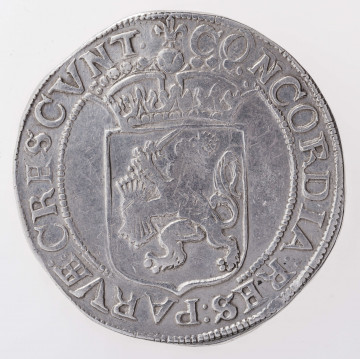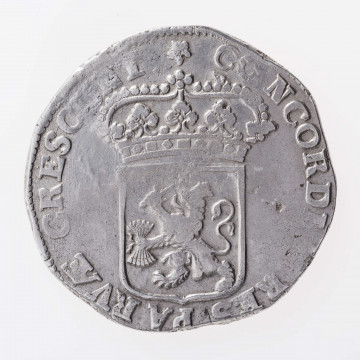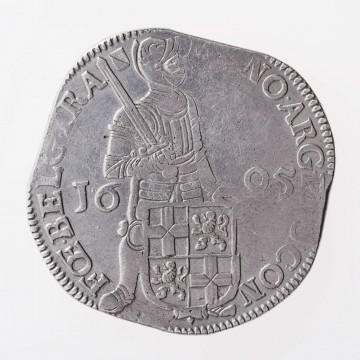
Silver ducat of the city of Kampen
1662
National Museum in Lublin
Part of the collection: Treasure of the 16th–17th c. coins from Józefów on Vistula
Formed in the Middle Ages, the Swiss Confederation, until 1648 part of the German Empire, was in the modern period a federation of cantons and cities possessed with extensive autonomy. Its territory, under French influence in the west and Italian in the south, was dominated by the reach of German culture, which, in addition to a common language, included a monetary system characterised by specific coin types and their mutual relations. The system was regulated by the minting ordinances of the German Reich, which the numerous Swiss cities, bishoprics and cantons authorised to issue money were obliged to apply. One of such centres was Basel as the capital of the canton and the bishopric. In this city, bishop's coins were minted since the 11th century, and from the Middle Ages municipal and cantonal coins.
The thaler, as a silver coin with high purchasing power, appeared in Europe in the last quarter of the 15th century. In the 16th century this denomination was adopted in the monetary systems of many European countries. The emergence of the thaler with a value equal to gold ducats was caused by the economic development of Europe and the needs of trade exchange. The scarcity of gold meant that this role fell to silver coins. The raw material for their production was provided by large silver deposits discovered in Europe and especially in Spanish colonies in South America.
The obverse of the thaler from Basel shows the coat of arms of the city (Baselstab) with the date 1621 on the sides and the inscription, in translation: ‘NEW COIN OF THE CITY OF BASEL’. On the reverse side, around the image of the eagle, is an inscription which in translation reads: ‘LORD KEEP US IN PEACE’.
The coin in question is part of a hoard of 83 thaler coins, hidden after 1708 in Józefów in the Biłgoraj region (the Lublin Voivodeship). The collection from Swiss issues also includes a thaler of the city of Sankt Gallen and a thaler of the canton of Zug. By way of trade they reached Poland in the second half of the 17th century together with German and Dutch thalers.
The thalers minted in Basel contained over 25 grams of pure silver, and in this respect were in line with the Polish issues.
At the turn of the 17th and 18th centuries the value of a thaler in Poland was equivalent to the cost of feeding a man for four weeks.
Tomasz Markiewicz
Author / creator
Dimensions
cały obiekt: width: 41 mm
Object type
numismatic
Technique
stamp minting
Material
silver
Creation time / dating
Creation / finding place
Owner
The National Museum in Lublin
Identification number
Location / status

1662
National Museum in Lublin

1695
National Museum in Lublin

1695
National Museum in Lublin
DISCOVER this TOPIC
National Museum in Szczecin
DISCOVER this PATH
Educational path